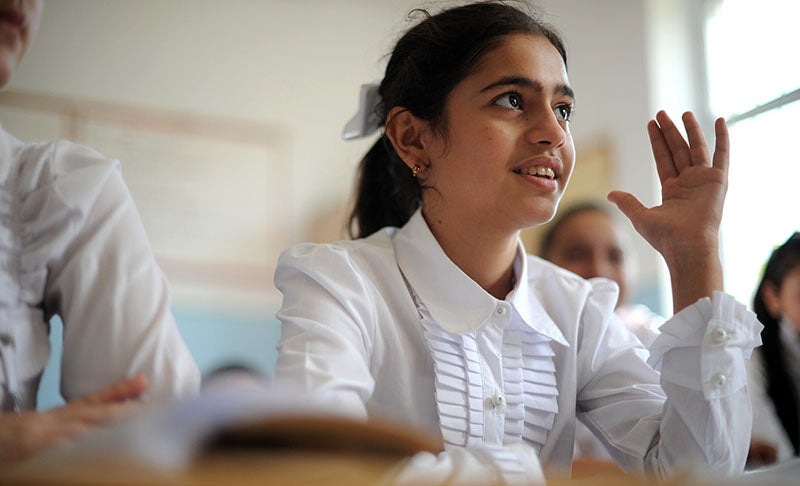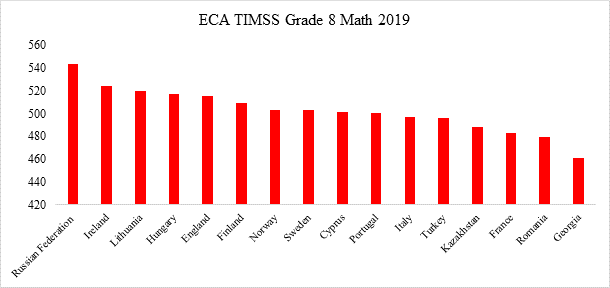 Khajiyeva Ilkana, 12, attends class at the Kalbajar School #56 in the Masazy settlement in Absheron Region. Azerbaijan
Khajiyeva Ilkana, 12, attends class at the Kalbajar School #56 in the Masazy settlement in Absheron Region. Azerbaijan
In December, the International Association for the Evaluation of Educational Achievement (IEA) released the seventh installment of the Trends in International Mathematics and Science Study (TIMSS). TIMSS 2019 was conducted at the fourth and eighth grades in 64 countries and 8 benchmarking systems by 580,000 students. Inaugurated in 1995, TIMSS has been conducted every four years since, providing 24 years of trends in mathematics and science achievement.
In grade 4 Math, the top performers, once again, came from East Asia: Singapore, Hong Kong SAR, Korea, Chinese Taipei (599) and Japan (593). They were followed by European countries, led by the Russian Federation, but at 567 points, this is more than 50 points, or a half a standard deviation, behind the global leader and represents more than a year’s worth of learning.
Some countries have shown tremendous progress over time. In grade 4 math, for example, since 1995, Portugal gained 83 points. This is almost two years’ worth of learning progress. The experience of Portugal’s reform is well documented by Nuno Crato. Following dismal first results in TIMSS and PISA, the education system was reformed to pay increased attention to results, with a clear curriculum, increased school autonomy, regular assessment, vocational paths, and flexibility. Large increases since 1995 are also reported for England and Cyprus. Other large increases occurred for Armenia, Azerbaijan, the Czech Republic, Georgia and the Russian Federation.
In grade 4 Science, the top performers are mostly from East Asia (Singapore, Korea, Japan, Chinese Taipei) but also include Russia, Finland, Latvia, Norway, the United States and Lithuania. The Europe and Central Asia (ECA) region has seen some large increases, including Cyprus with a 61-point gain since 1995; also, Armenia, Georgia, Portugal and Russia. Armenia’s significant improvement come at a time when the World Bank pointed to high levels of Learning Poverty. Reform efforts are finally paying off. Over the decade, Armenia has focused on assessment, supported in part by efforts to enhance the country’s capacity in student assessment.

Several countries in the region recorded low scores. Among these were several Western Balkan countries. Despite their improvement over time, Armenia and Georgia are still scoring below the TIMSS mid-point. Fortunately, reform efforts there are on-going. A recently approved World Bank operation in North Macedonia and on-going support in Kosovo should help address learning needs. On the other hand, Serbia is scoring above Spain and France, and Albania has surpassed France, albeit slightly. The rest of the Western Balkan countries are performing better or as well as some high-income countries.
In grade 8 Math, the top performers are also from East Asia: Singapore, Chinese Taipei, Japan and Korea. They are followed by the Russian Federation, Ireland, Lithuania, Israel and Australia.

The most-improved performer in the world in grade 8 math since 2015 is Turkey with a 38-point gain in math and 22 point increase in grade 8 science. This is most likely due to eventual success of reforms that started in 2005, and continued in 2013 and 2017. The Ministry of National Education (MoNE) credits the establishment of measurement and evaluation centers in each province and the development of standards with its success. Improved teaching and digital content is also recognized (via the EBA – which the World Bank is supporting in the Government’s COVID-19 response). Other factors may include physical improvements in learning environments. Other big improvements in TIMSS were observed in: Cyprus, Georgia, Romania and the Russian Federation. Overall, Cyprus’ positive trends seem to suggest that reform efforts are starting to bear fruit. The positive trends in Georgia are a continuation of a trend that goes back several years; still, as the OECD finds, Georgia needs to strive for equitable performance across all population groups going forward. TIMSS began in 1995; since then, biggest improvements for grade 8 math have come from: Portugal (49-point gain); Lithuania (48-point gain); and Cyprus (33-point gain).
In grade 8 Science, the top performers are mostly from East Asia: Singapore, Chinese Taipei, Japan and Korea; followed by the Russian Federation, Finland and Lithuania. Since 1995, in grade 8 science, Lithuania has recorded a 70-point increase. Since 2011, Turkey has seen a 32-point gain, Georgia 27 points, and Lithuania 20 points. Cyprus has seen a 43-point rise since 2003.
Russia’s improvement and high performance in both subjects and grades is worth reflecting on. The country prioritizes the preparation of mathematics teachers, especially for students with low family academic resources. Also, the use of assessments and exams, and increased attention to poor performers has led to reductions in inequalities, for example, between rural and urban, as well as rich and poor. Other factors may include reforms implemented in the early 2000s, such as liberalization of the textbook market, diversification of the primary school curricula, and growth in innovative pedagogy across Russia. The comprehensive reform of the student assessment system is important for understanding the country’s results. It is also a lesson for other countries.
Going Forward
Important international studies such as TIMSS are useful in identifying broad trends, but there is no substitute for careful causal inference analysis carried out in a country or region in order to determine what works in those contexts to improve student learning. The microdata and context questionnaires will allow for more in-depth analysis of related areas such as home environment, school and classroom contexts, and attitudes towards learning. This also makes possible the analysis of trends more systematically.
It is also worth keeping in mind that these scores refer to the period before the COVID-19 pandemic and school closures. They serve as a benchmark as we look towards the next round. Hopefully, learning recovery efforts and much-needed reforms will allow us to see gains in the next release.




Join the Conversation